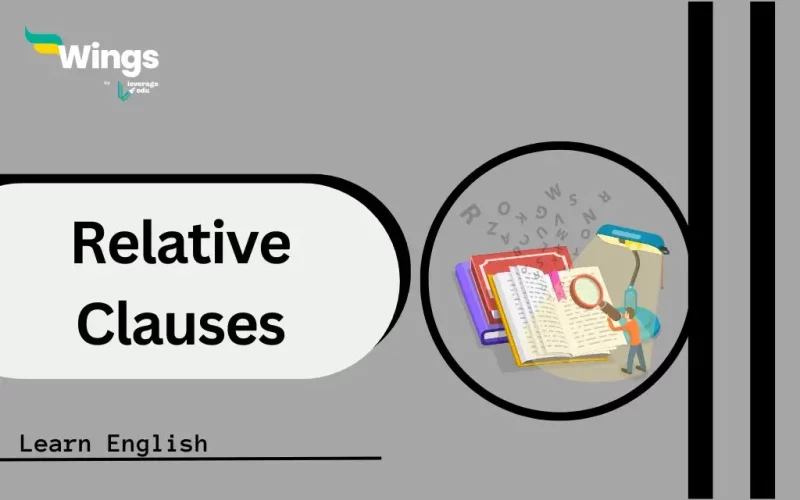In the English language, nouns are independent clauses that can be modified by dependent clauses, known as relative clauses. To form a complete concept, a relative clause must always start with a relative pronoun and link to an independent sentence. For example, “My sister, who is a nurse, works at the hospital”. To learn more about these clauses, hop on and read this blog till the very end. It will guide you through the usage of relative clauses with the help of examples and practice exercises.
Learn all about Clauses in English Here!
Definition of Clauses with Examples
A clause comprises a subject and a predicate. A particular sentence can have as many subjects and verbs as possible. A clause communicates information about what the subject is or is doing. It can serve as a standalone sentence because it describes an action or a state of being”. For example: “Although he doesn’t like coffee, I can drink juice”.
Also Read: What are Clauses: Definition, Types
What are Relative Clauses?
A relative clause is a type of subordinating clause that provides additional information about a noun or pronoun in the main clause. Relative clauses typically begin with a relative pronoun (such as “who,” “whom,” “which,” or “that”) or a relative adverb (such as “where,” “when” or “why”).
Types of Relative Clause
As mentioned above, a relative clause includes subject and predicate; it is also a dependent clause. There are two types of relative clauses which are restrictive relative clauses and Non-relative clauses.
Defining clauses
These are referred to as restrictive or defining relative clauses. A comma is never used to separate a defining relative phrase from a noun. Explaining with the help of example.
“The students who study the most will likely get the best marks.”
Non-defining clauses
These are either non-restrictive or non-defining relative clauses. Commas are used to divide these individuals. Typically, it is a common or proper noun that designates a special person, object, or occasion. It is also known as a non-essential clause. For example:
“The India Gate which is located in Delhi, is a famous landmark”.
11+ examples of relative clauses
Below are some common relative clause examples that will give you a better understanding and knowledge of relative clauses.
- The novel that I bought yesterday is a bestseller.
- The house where she grew up has been renovated.
- The person who won the award is my sibling.
- The cake that he baked for the party was delicious.
- The bike which was parked in front of the store was stolen.
- The teacher whose class I’m in is very knowledgeable.
- The movie that he saw last weekend was directed by Spielberg.
- The company where my cousin works is expanding globally.
- The cat that meows loudly belongs to my neighbour.
- The frock that she wore to the party was stunning.
- The park where they had a picnic last summer offers breathtaking views.
- The song that we’re listening to is my favourite.
Practise Exercise for Relative Clause
Instruction: For each of the following sentences, add an appropriate relative clause
- The novel _________ borrowed from the library was engaging.
- The woman __________ lives next door is a nurse.
- The bike ______________was parked in front of the house belongs to my friend.
- The series ____________ we watched last night was exciting.
- The cafe _____________ we had brunch last week had delicious food.
Answers
1. The novel (that/which) borrowed from the library was engaging.
2. The woman (who/that) lives next door is a nurse.
3. The bike (which/that) was parked in front of the house belongs to my friend.
4. The series (that/which) we watched last night was very interesting.
5. The cafe (where) we had brunch last week had delicious food.
FAQs
As mentioned above, A clause comprises a subject and a predicate. A particular sentence can have as many subjects and verbs as possible. For example, The bike which was parked in front of the store was stolen.
“Relative clause”, which stands in for a noun, a noun phrase, or a pronoun when sentences are joined, always appears at the beginning of a related clause.
Relative clauses fall into two categories, non-restrictive and restrictive clauses.
Find more grammatical read below
| Interrogative Adverbs | What are Nouns? |
| What is the Difference Between Nouns and Pronouns? | Learn English Grammar from Scratch |
| Nouns Archives | Adjective vs. Adverb |
This was all about the relative clause and their usage in English grammar. Hope you understand the concept and know how to proceed. You can also follow the Learn English page of Leverage Edu for more exciting and informative blogs.
 One app for all your study abroad needs
One app for all your study abroad needs















 45,000+ students realised their study abroad dream with us. Take the first step today.
45,000+ students realised their study abroad dream with us. Take the first step today.
